After a 122-day layoff, the return of Italian football was welcomed with an intriguing Coppa Italia semi-final 2nd leg fixture. Inter and Napoli would battle out a tightly fought contest in the San Paolo stadium for a place in the final against Juventus.
Napoli entered the game with a one goal lead and the benefit of the away goal ruling meaning to progress a 0-0 draw would have been sufficient. The tie could not have started any better for Inter, however, who cancelled out Napoli’s first leg away goal by going 1-0 up from a direct corner taken by Christin Eriksen in the 2nd minute of the game. From that point on, Inter largely dominated possession but found it difficult to penetrate Napoli who remained compact out of possession. Although Inter had far more chances, they could not capitalise on them and with Napoli equalising just before half-time, that was enough to send the Gli Azzurri through.
This tactical analysis will analyse how Napoli’s compact shape allowed them to prevent Inter from penetrating centrally, and how Inter attempted to break down Napoli’s defensive structure using rotations and the half-space.
Lineups
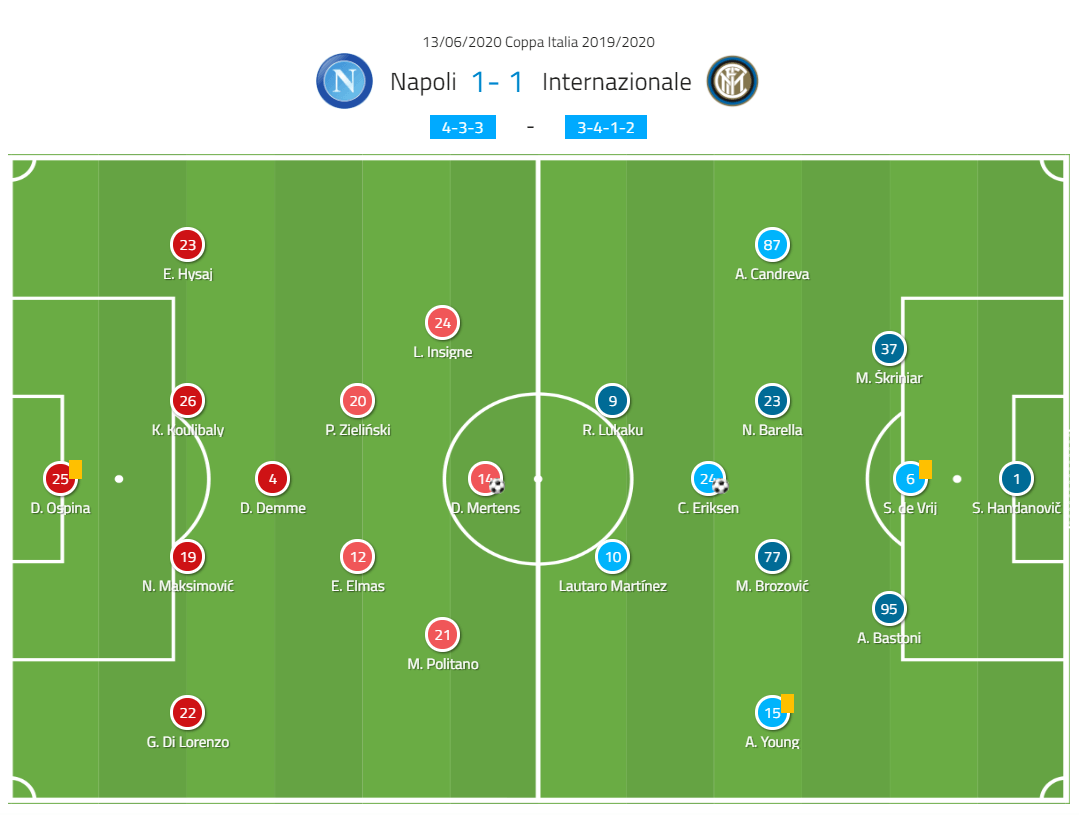
Antonio Conte tweaked his tactics adapting Inter’s customary 3-5-2 formation to a 3-4-1-2 with Eriksen playing slightly higher than Marcelo Brozović and Nicolò Barella in an attempt to position him in his favoured number ten role. Additionally, 22-year-old defender Alessandro Bastoni entered the back three as a right-sided centre-back replacing an injured Diego Godín.
Napoli opted for a 4-3-3 formation with Dries Mertens leading the line, often taking the role of a false nine in a fluid front three. Defensively, Napoli was without Kostas Manolas and central midfielder Fabián Ruiz who had scored in the first leg was only fit enough to make the bench with Eljif Elmas coming in as a replacement to make up the midfield three.
Inter exploit space behind Napoli’s first line of pressure
When building the attack in their defensive third, Inters’ midfielders often vacated the central zone and took up wider positions close to the wing-backs. This spread the opposition midfield and allowed Inter to play penetrative passes straight into the feet of their dynamic front two, Romelu Lukaku and Lautaro Martínez who stretch the opposition by remaining high up the pitch. This occurs when Brozović is man-marked and cannot receive the ball from the centre-backs when dropping deep, and also allows for another midfielder to arrive into the space he has vacated under less pressure.
When Inter passed backwards or attempted to play out from the back using their goalkeeper Samir Handanović, this was a trigger for Napoli gain territory by stepping up higher and having their front three press the Inter backline. Napoli would press in a fairly narrow triangle with Mertens at the highest point, and a central midfielder such as Elmas supporting from behind and preventing Brozović from receiving the ball forming a diamond as seen below.
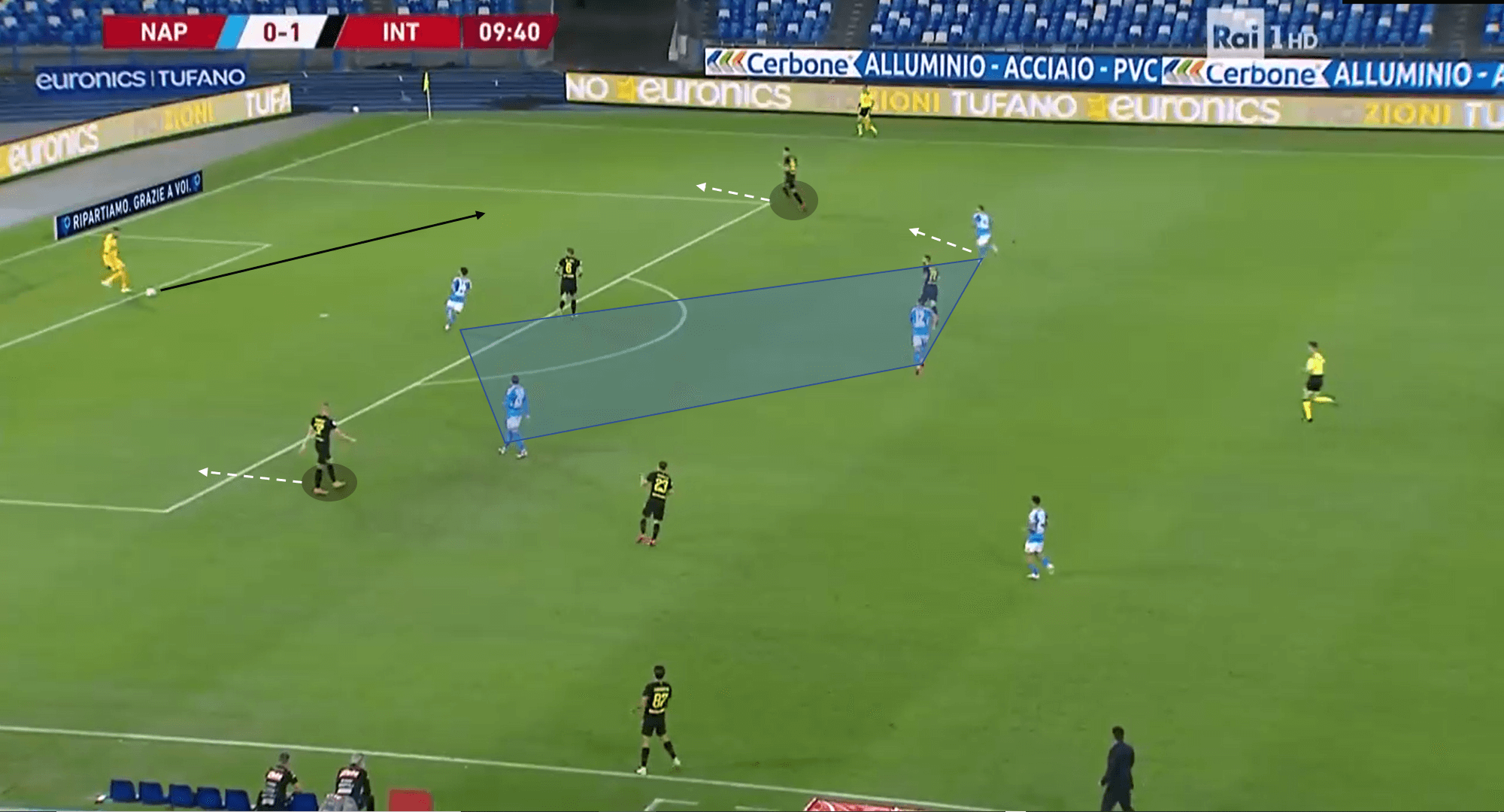
The compact diamond shape Napoli adopted when pressing forced Inter to play to either the left or right-sided centre-back. Bastoni and Škriniar drop on either side of the Napoli diamond to receive the ball from Handanović who passes to Bastoni on this occasion. Brozović, who is marked tightly within the diamond vacates the central area taking his marker, Elmas, with him, which allowed Barella to enter into the space just behind Napoli’s frontline pressure.
As the ball travels to Bastoni, De Vrij, who is playing as the central centre-back positions himself higher than Bastoni forcing Mertens to shift to his right (instead of pressing the goalkeeper) to prevent a pass to de Vrij which may break their press. This leaves Handanović open as the free man allowing Inter to switch the play if necessary.
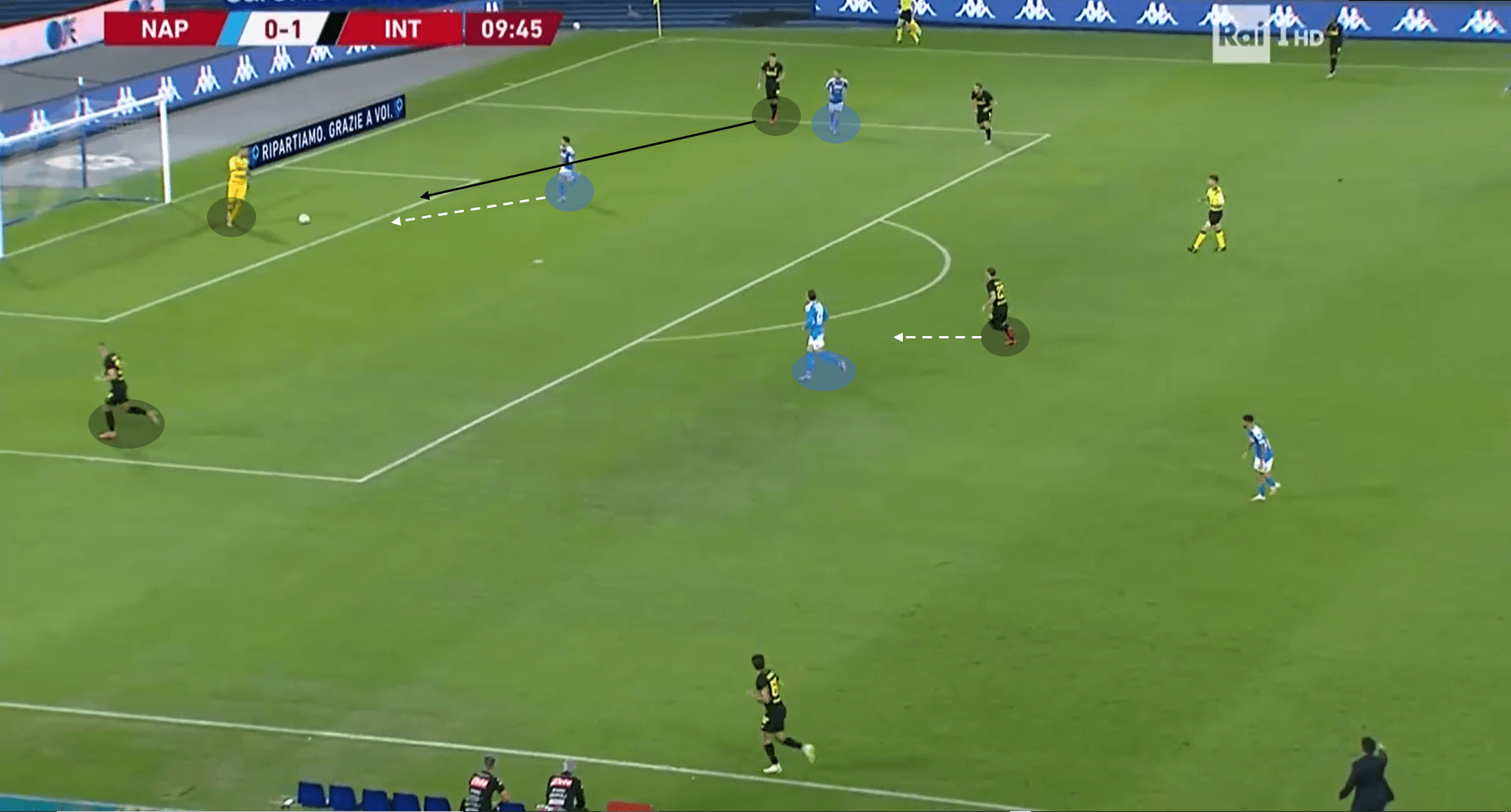
As Bastoni is pressed aggressively, he plays the ball back to Handanović whilst Škriniar provides support on the other side of the box. Barella now enters the central area which Brozović vacated, causing a problem for the Napoli on the other side as once again, they must remain narrow to avoid Handanović playing a split pass through and penetrating their press. This gives left centre-back Škriniar space to receive the ball as a result
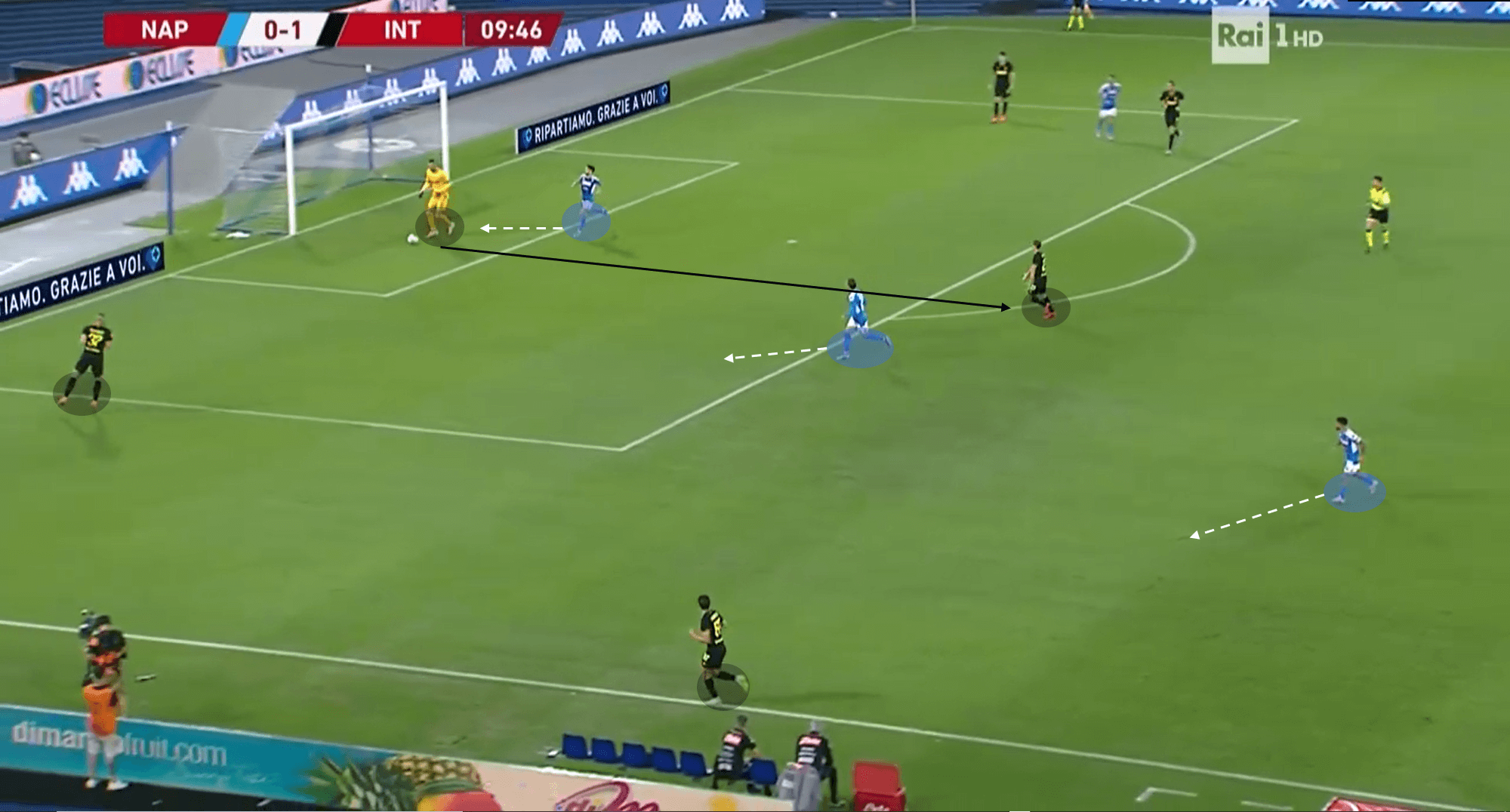
Handanović’s body shape facing Škriniar deceives the Napoli players who all focus on pressing him into the left corner of the picture above. Although slightly risky, Handanović plays against the pressure and find Barella on the edge of the D, breaking the Napoli press and allowing Inter to advance up the pitch.
Additionally, by Inter committing up to seven players to their build-up, this drew Napoli players out of the central area and created passing lanes into Lukaku and Martínez who dropped into the empty space created to receive the ball as evident below. Martínez enters the vacant central area and with one penetrative pass by Škriniar seven Napoli players (one out of shot in the left corner) are eliminated and are must recover quickly.
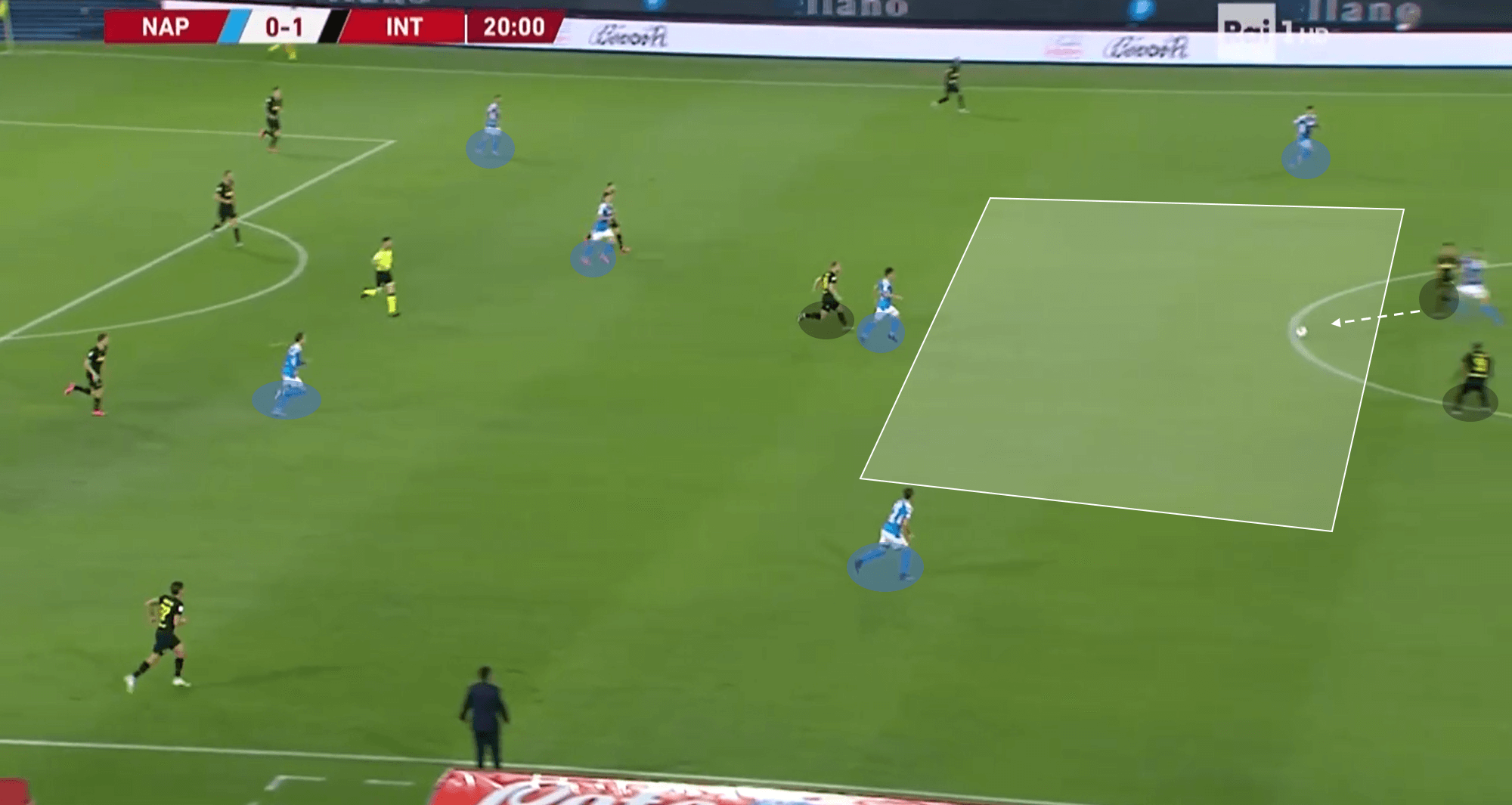
Napoli’s high press onto the left and right centre backs was nullified more often than not as Inter built attacks from their defensive third frequently by remaining patient in possession using Handanović. The goalkeeper gave Inter numerical superiority as the free man during their build-up which allowed Inter to break Napoli’s pressure.
Inter struggle to break down Napoli’s compact mid-block
When Napoli’s pressing was unsuccessful, they would recover into a mid-block as quickly as possible, adopting a compact 4-3-3 formation preventing any passing lanes through the centre. Throughout the game, Inter dominated possession with 66% and over double the average possession duration, 23s as opposed to 11s. Napoli’s narrow shape often forced Inter into using their wing-backs who then recycled the ball back to the back three as they waited for an opening. Napoli was largely successful in preventing any passes being playing into Lukaku and Martínez directly. Inter’s lack of penetration can be highlighted further by Martínez’s performance which was below his normal standards with the lowest number of actions of an attacking player on either team, 33, and only 13 of those were successful, (39%).
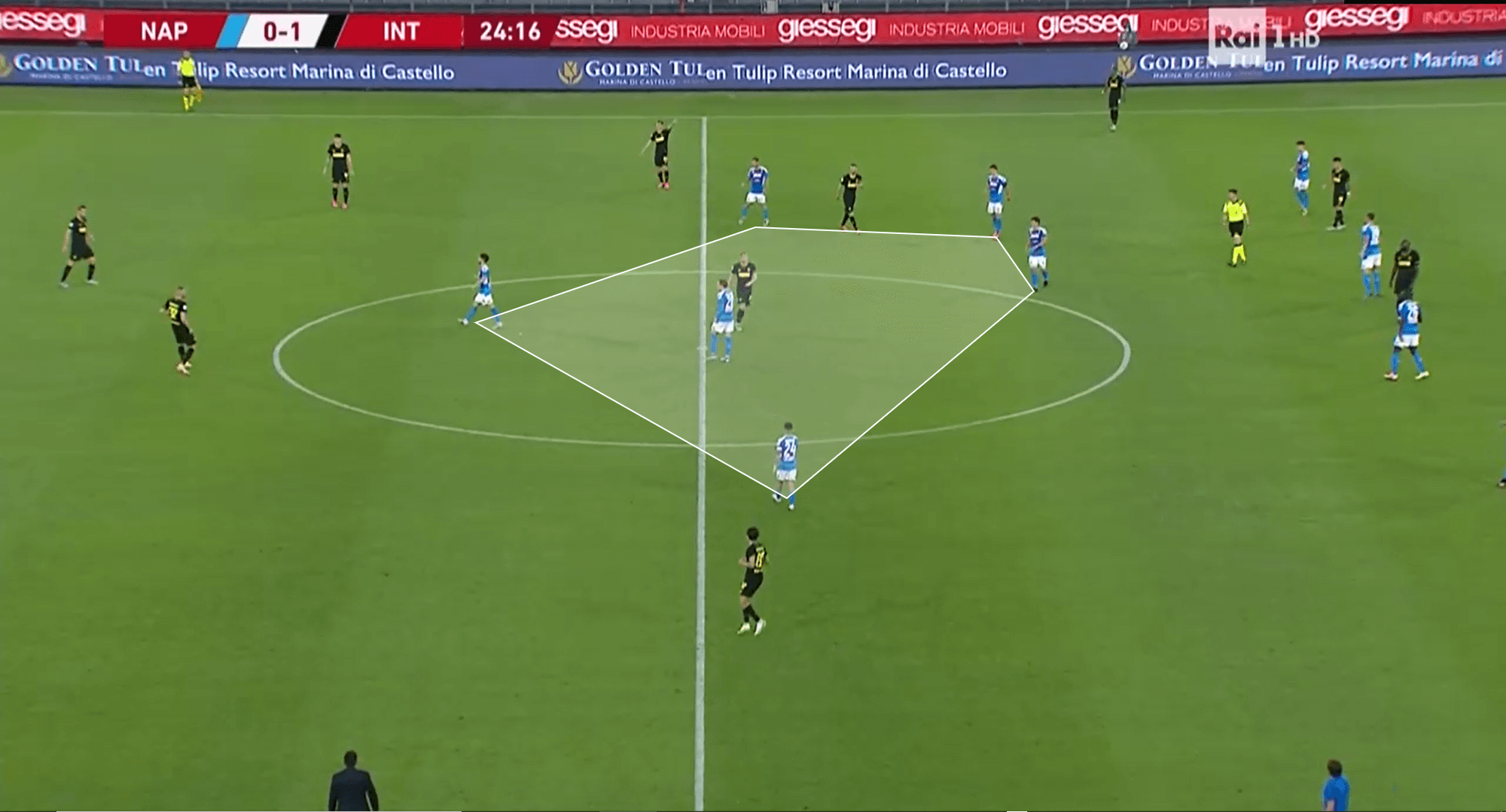
Above, we can see the typical shape Napoli adopted when dropping into a mid-block leaving little to no vertical passing lanes through to Lukaku, Martínez or Eriksen open. Eriksen, in particular, is surrounded by opposing players in the white area. Inter are forced to play in front of Napoli with their centre-backs or around them by using the vacant space which their wing-backs Ashley Young and Antonio Candreva occupied either side of Napoli’s midfield and front three. This often resulted in them maintaining possession without posing any threat and meant Inter frequently circulated the ball in a U-shape finding it difficult to play through Napoli.
Inter use rotations to create space
Pre-occupied space can lead to static positioning resulting in players that are much easier to mark. A player that is arriving into space is much harder to handle than a player waiting in space, thus, coordination of movements is key when rotating. Often rotations can be used to create space, generate superiority and create progressive passing options. In a search for space, Inter often used rotations between their left or right-sided centre-back, the wing-back, and centre midfielders Barella or Brozović. For example, as the ball travelled across the back three from left to right, Barella would drop down into Škriniar’s position and Škriniar would move high and wide taking up the wing-back position. Simultaneously, the wing-back Candreva would tuck inside into the half-space in between the Napoli full-back and wide midfielder as seen below.
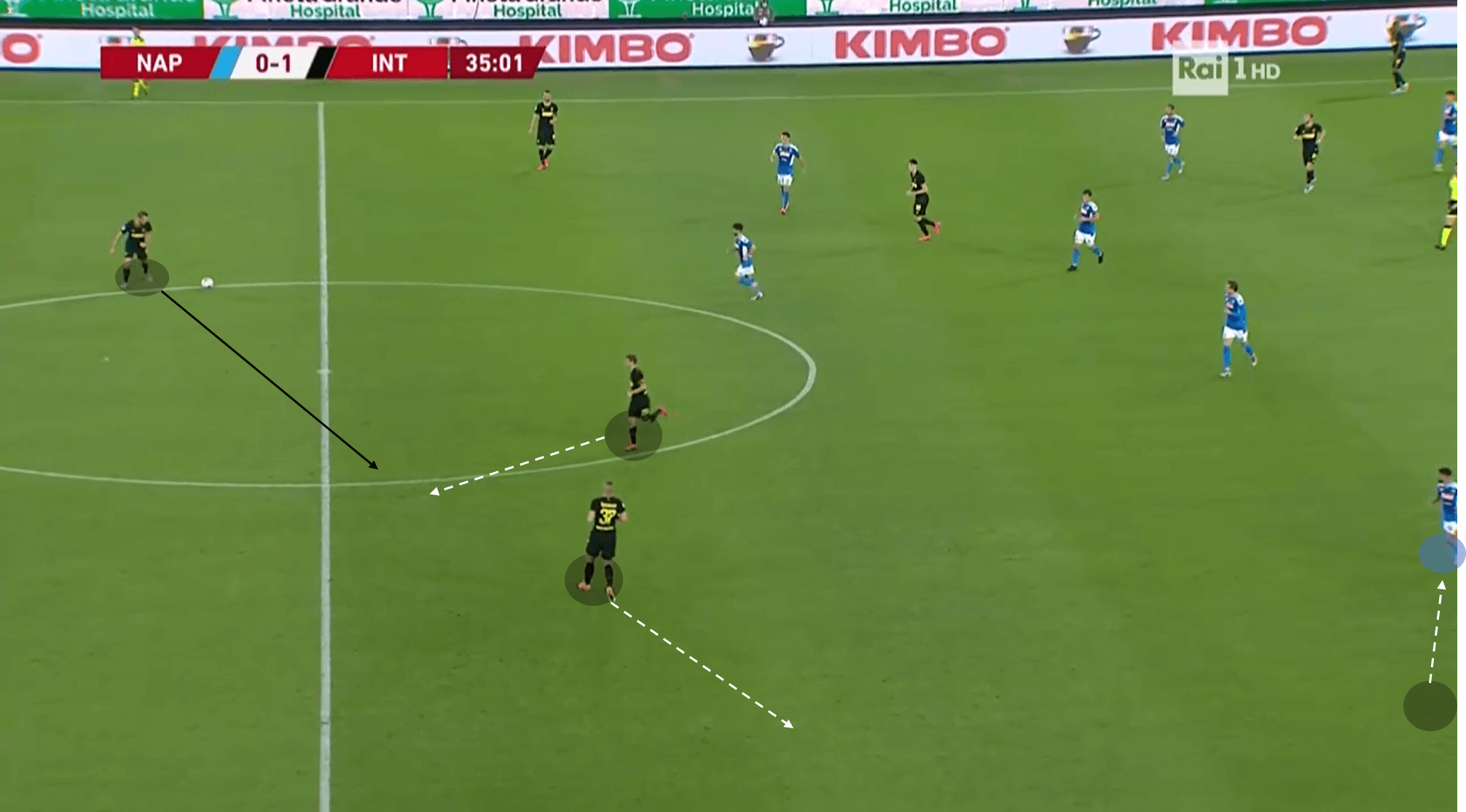
Napoli allows Barella to receive the ball as he does not provide a direct threat and they can maintain their defensive structure. However, Candreva’s movement into the half-space causes Napoli problems as Insigne recognises this and tucks inside to block any passing lane that could be created between Barella and Candreva. Additionally, the full-back tucks inside as cover in case Candreva does receive the ball. This free’s up space for Škriniar down the flank and Barella exploits this by playing forward into the vacant area past Insigne, see below.
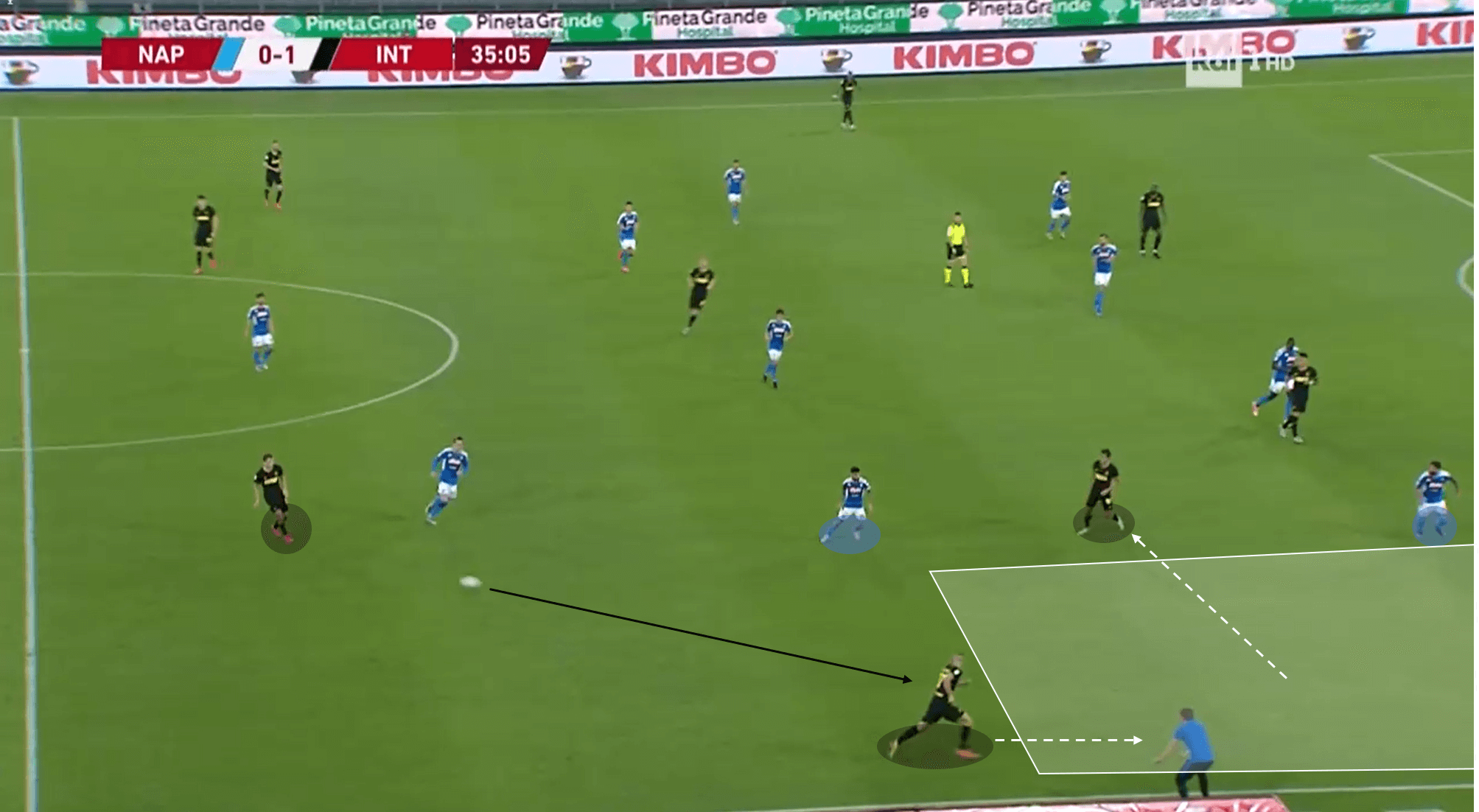
Napoli’s full-back attempts to close down Škriniar but due to his decision to tuck inside and mark Candreva, he cannot get out to the flank in time to stop the pass down the line. As the full-back comes across leaving space behind him, Candreva makes his run in behind the Napoli full-back (blindside) disrupting Napoli’s defensive structure and forcing centre-back Kalidou Koulibaly to come across. This created space in the box as the Napoli backline was stretched in attempts to cover the spaces which Inter created as a result of their rotation.
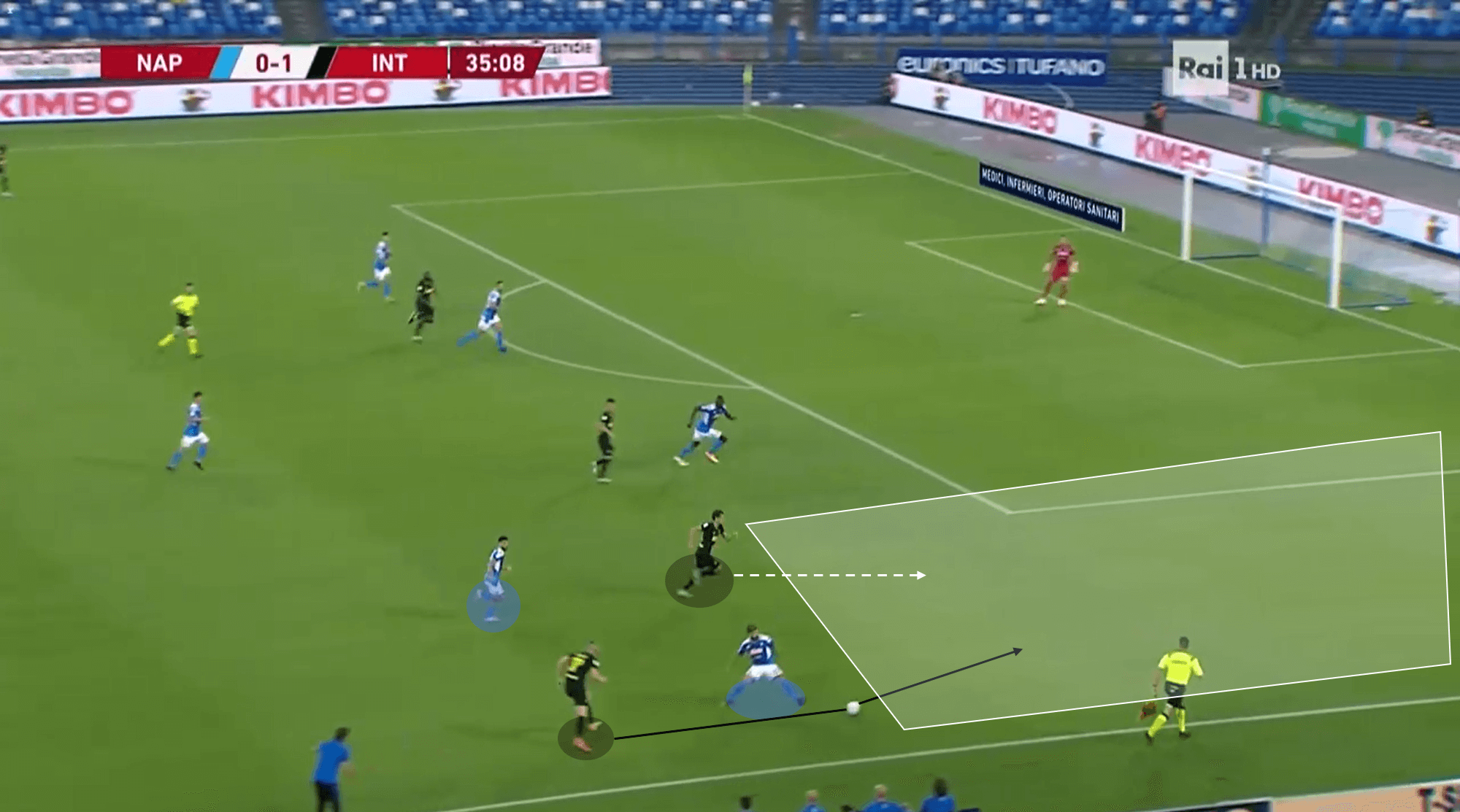
This rotation was something they tried throughout the game in attempts to break down Napoli’s defensive shape. Inter did manage to create chances through crosses as a result of this rotation, however, throughout the game, they were unable to create enough quality chances which was indicated by their xG of 1.31 in the game.
Napoli struggled during the build-up
Over the course of the game, Napoli had an xG 0.76 and managed just two shots on target. Although Napoli had a greater number of possessions than Inter (96 compared to 90 possessions), they were unable to sustain any significant period of possession, as mentioned previously averaging 11s compared to Inters’ 23s. Furthermore, just seven of Napoli’s possessions reached the opponents’ penalty area.
With Lorenzo Insigne and Mertens as two of Napoli’s front three players, aerial duels were not a favourable option due to their height, and the strength of Inters’ centre-backs in the air. In addition to this, when Napoli tried to play out from the back or circulate the ball in their half, they suffered significantly due to Inters’ aggressive man-orientated press evident below.
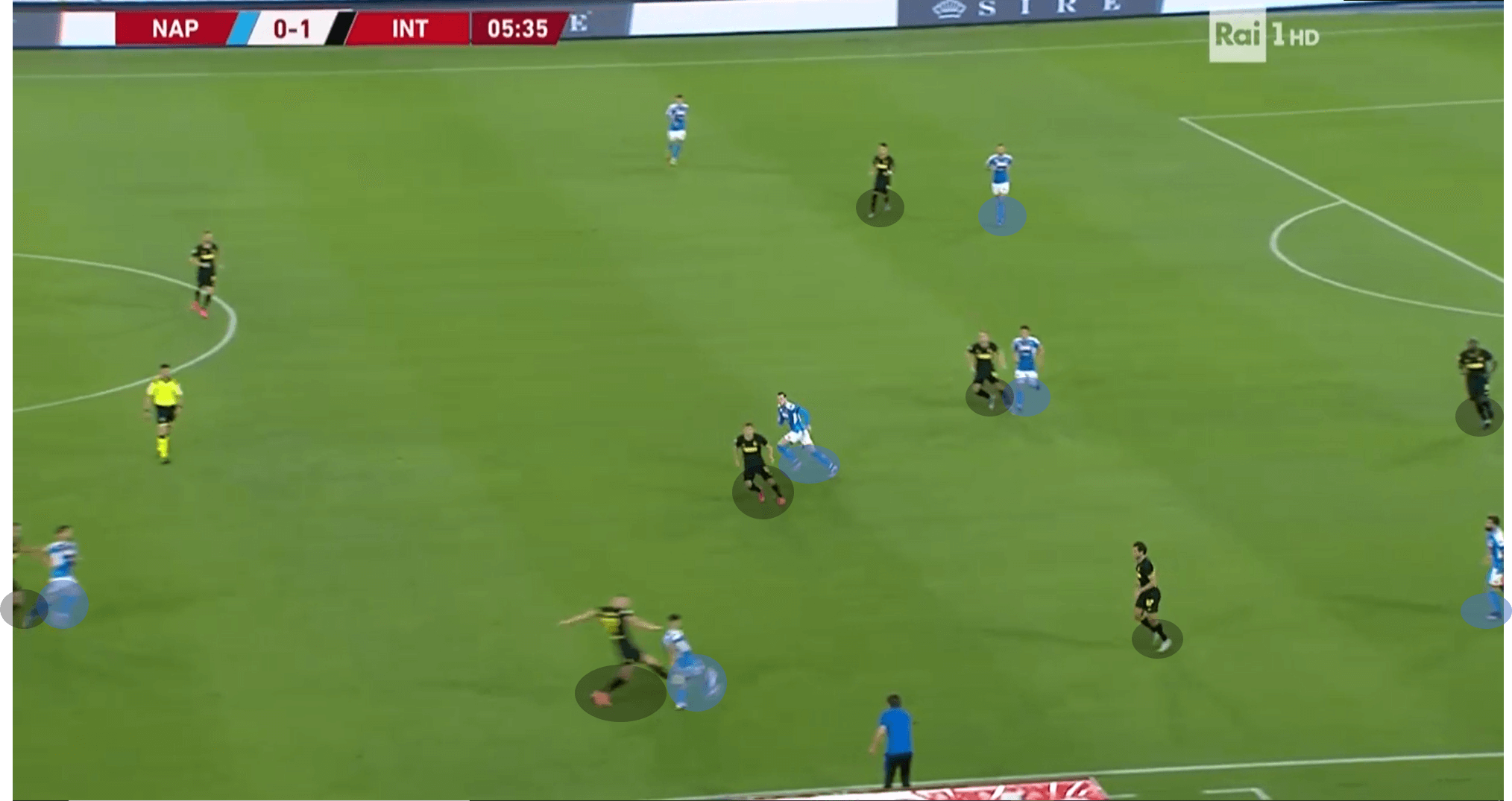
Above, we can see how tight Inter pressed each Napoli player on the ball side. With Inter committing so many players forward to press it became extremely difficult for Napoli to maintain possession as passing options were shut off instantly. Inter would rarely press the goalkeeper. Once the ball left the goalkeeper and a centre-back of full-back received the ball, Lukaku or Martinez would curve their run, shutting off the pass back to the goalkeeper and nullifying the option to use him as the free man. This allowed Inter to match up 1 vs 1 on the ball side in Napoli’s half making it extremely difficult for Napoli to maintain possession due to limited passing lanes. As a result, Napoli often turned the ball over in the midfield third and the ball was collected by the Inter backline
Offensive rewards are few and far between for Napoli
The little success Napoli had was found during counter-attacks, and at times when Mertens played as a false nine causing problems in between the defensive and midfield lines. Inters’ one counter-attack compared to Napoli’s five provides context for this analysis. Napoli was organised defensively and frustrated Inter who were unable to penetrate centrally resulting in a large proportion of possession which posed a minimal threat. On the contrary, Inter committed significant numbers forward which left them exposed at times and they were punished just before half time.
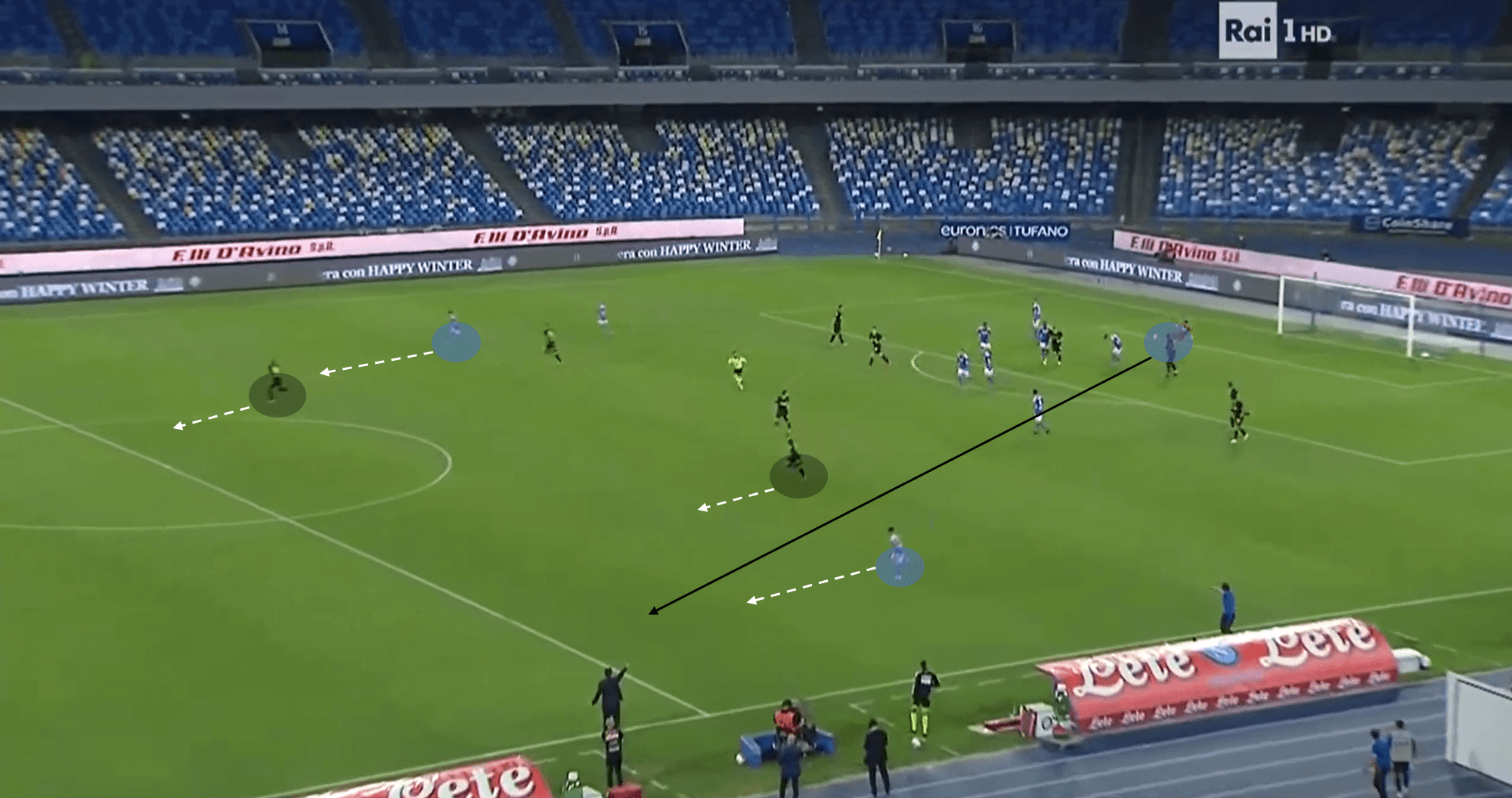
On an Inter corner, Napoli positioned their rest attack of Mertens and Insigne on either flank. This meant Inters’ rest defence and the subsequent cover was split on either side of the pitch with huge spaces to cover if the ball was lost. Ospina collected the ball after Inter played the ball back into the box. As Inter were drawn to the ball, the goalkeeper recognised instantly that Insigne had been left alone on the left flank. Ospina produced a fantastic pass into Insigne’s stride to initiate a counter-attack and a 2 vs 2 scenario with Mertens and Insigne attacking a trailing Eriksen and Young, see above.
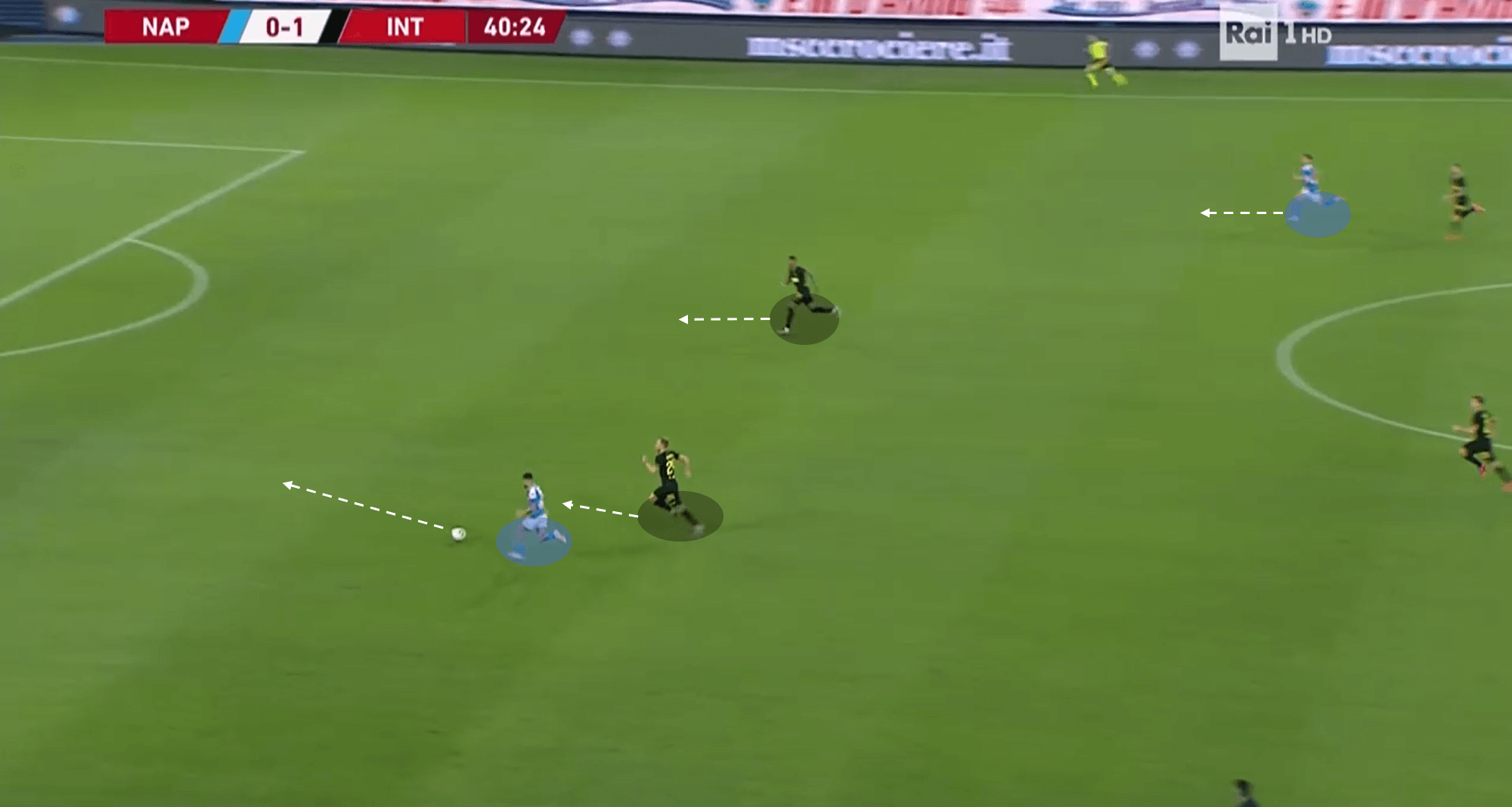
Neither Eriksen nor Young was able to stop Insigne entering the box and squaring the ball across the box. Mertens arrived on Young’s blindside and finished calmly to put Napoli ahead on aggregate just before half time.
Apart from a counter-attack, Inter were largely in control of the game even when out of possession. Their formation allowed them to drop into a 5-3-2 where necessary meaning that they had adequate cover when out of possession and used their numerical superiority to overcrowd Napoli and regain possession. Due to the tight spaces around Inters’ backline, on the rare occasion Napoli did have success, it was Mertens who provided it, acting as a false nine and vacating zone 14 in order to drag out his marker and create space for others to exploit.
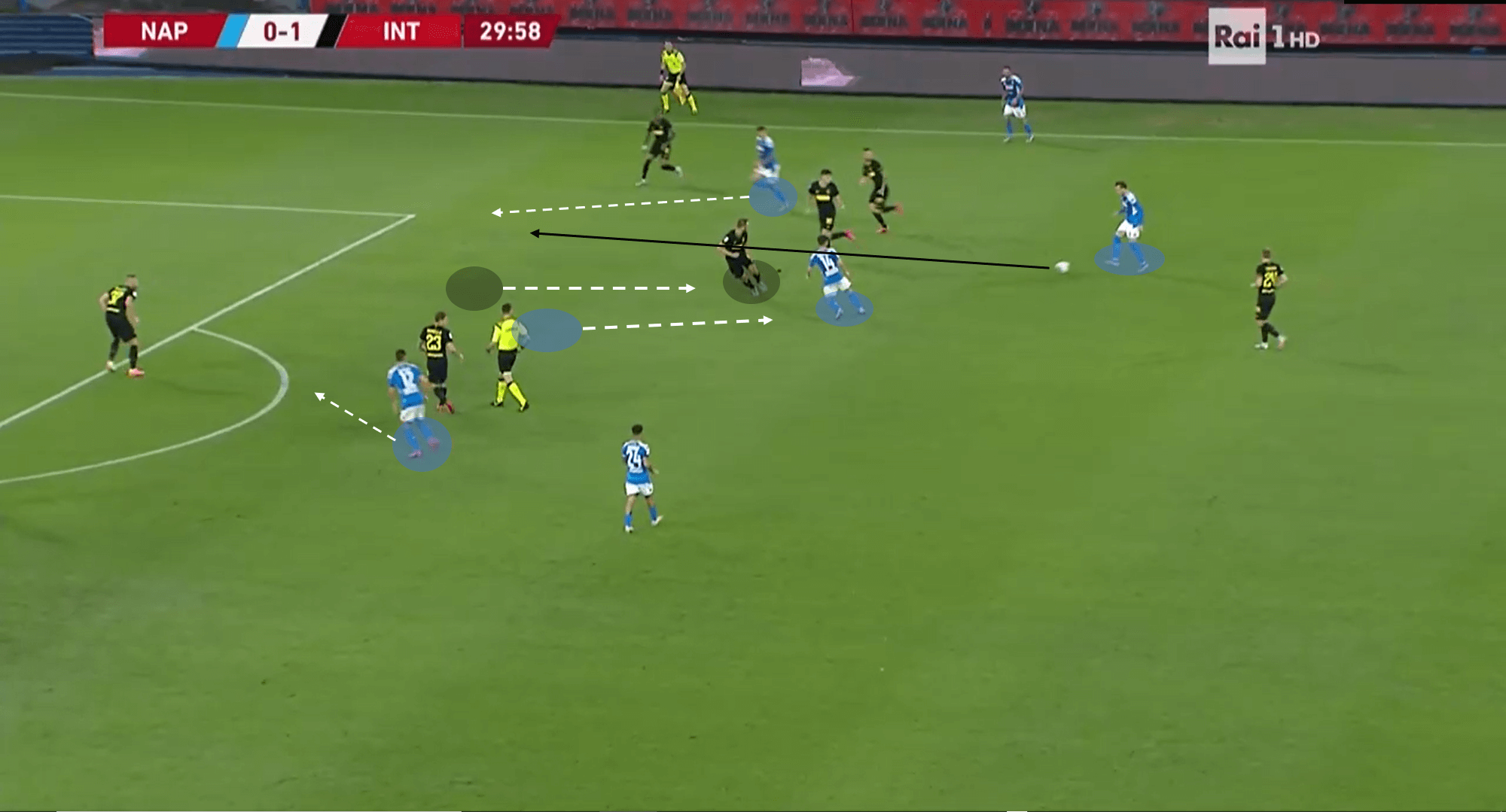
Above, we can see Mertens has vacated zone 14, dragging out de Vrij who has followed him leaving a dangerous space in behind the Inter backline. Mertens coming short to receive the ball acts as a decoy run disrupting Inters’ defensive structure and acting as a trigger for Napoli players to make runs into the space he has created. The ball is played through the disjointed Inter backline and Napoli create a crossing opportunity inside the box.
Inters search for superiority fails
As the game progressed Inter became more and more frustrated as they were unable to penetrate Napoli through central areas. In desperate need for a goal, Inter pushed their wing-backs extremely high and for the last 15 minutes, often formed a situational 2-3-5 in possession. To counteract this, Napoli dropped into a low-block leaving no space for Inter to play through them centrally, make use of the half-space, or play in behind them.
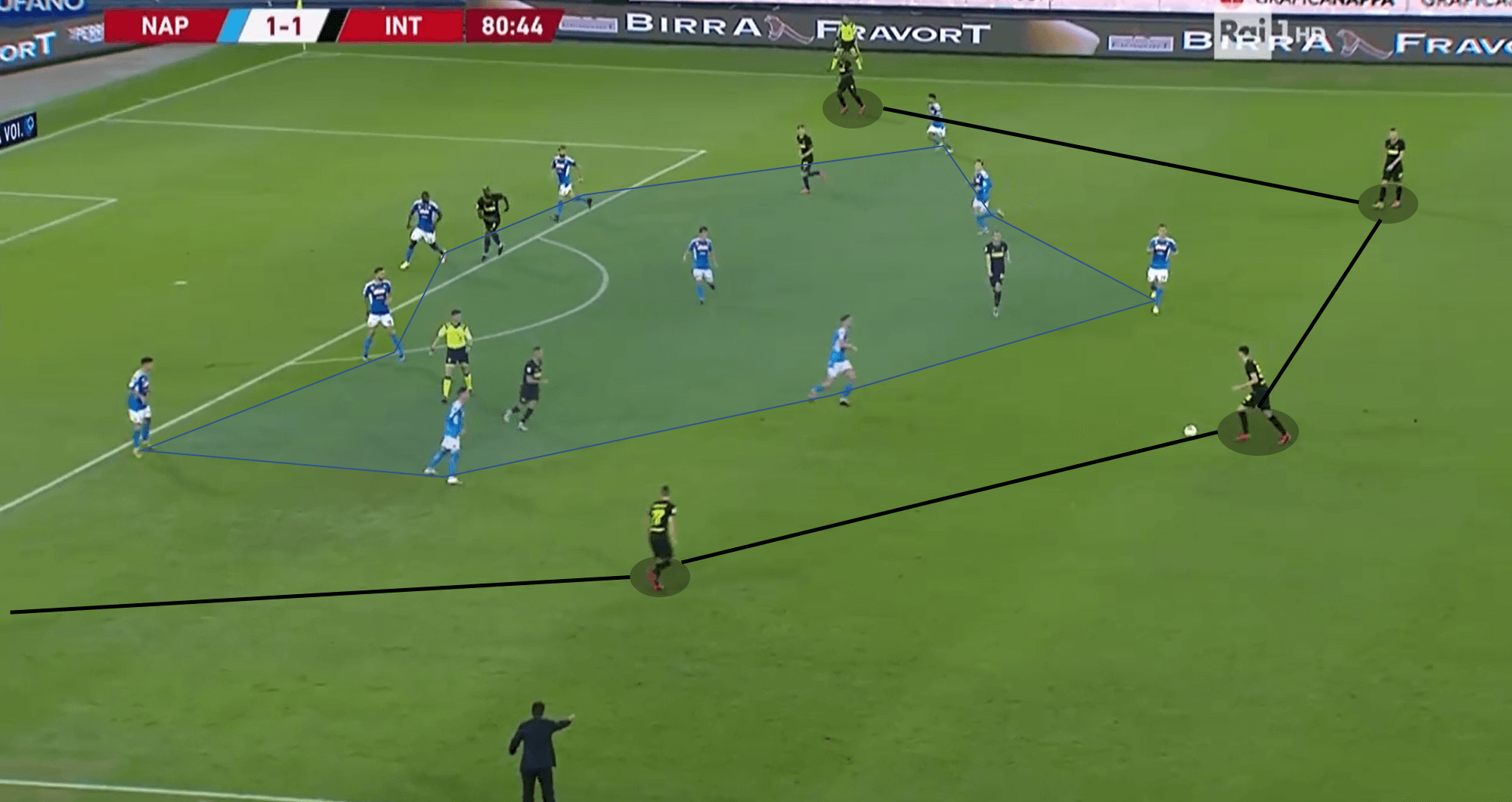
Evident above, for all their possession, Inter struggled to draw Napoli out and create superiorities in the attacking third. Inters’ play became predictable and despite searching for spaces in between the lines, they succumbed to playing in a U-shape as mentioned previously. Inter were unable to penetrate Napoli and could only manage to create crosses from the wing-back position in the final minutes which Koulibaly and Nikola Maksimović dealt with fairly comfortably winning a combined 78% of their aerial duels.
Conclusion
In what was a long-awaited return for Italian football, it is Napoli who go through to face Juventus in the final. Napoli may count themselves lucky in this game as they created very little relying on their away goal scored in the first leg over three months ago. Inter will be disappointed with the result as they overshadowed Napoli in possession but were unable to penetrate their compact defensive structure.





Comments